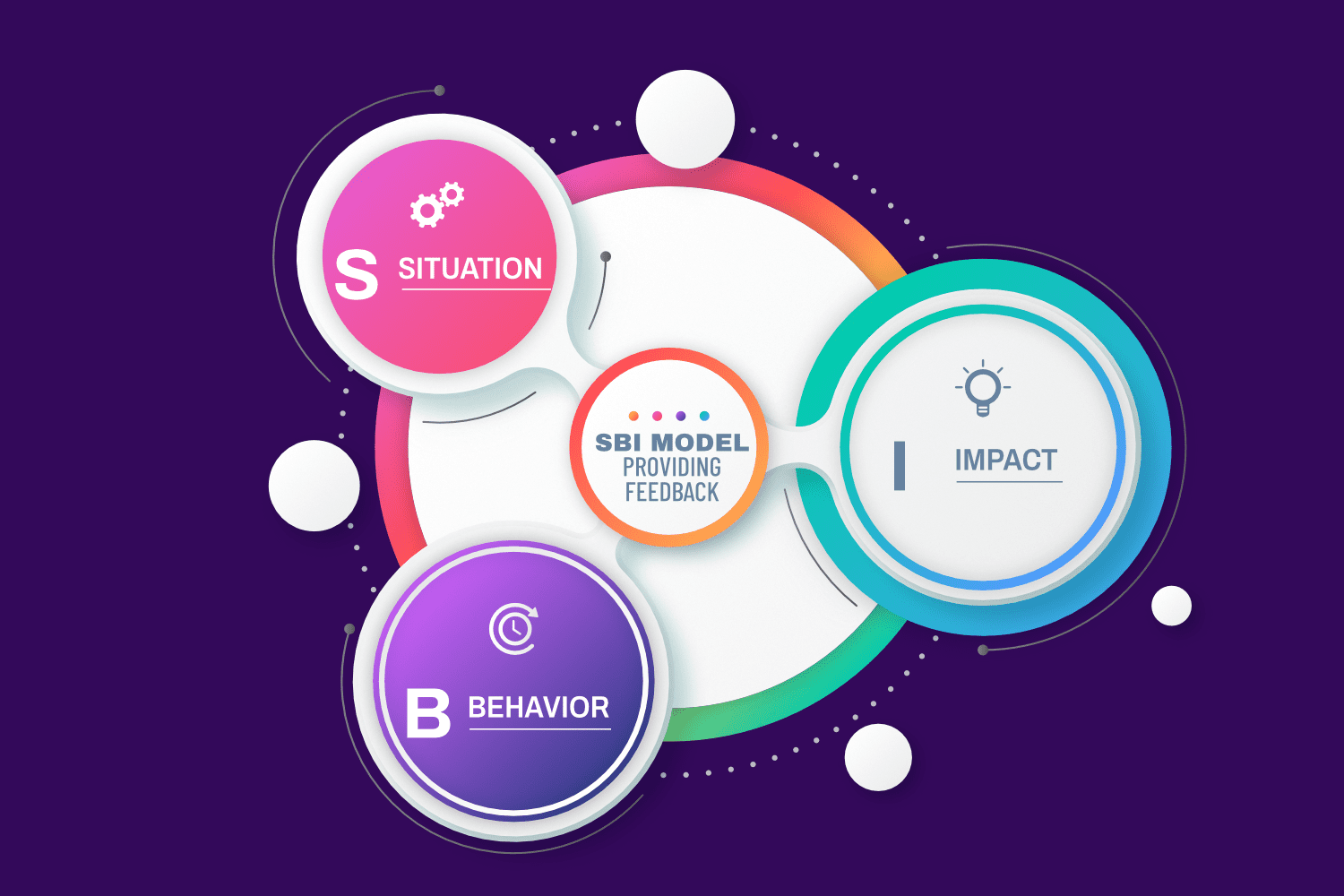As a leader, one of your core responsibilities is to provide feedback to colleagues and team members in a professional manner.
The SBI (Situation-Behavior-Impact) model is a great way to structure your feedback so that it comes across more as supportive rather being critical.
What Is the SBI Model?
The SBI model is a widely popular framework for giving constructive feedback.
It stands for Situation, Behavior, and Impact.
This approach helps you focus on the facts while still conveying empathy and understanding.
First, you start by describing the situation in which an issue came up. Then, you focus on describing the behavior of those involved without making judgments or assumptions about their intentions or motivations. Finally, you explain the impact of the situation or behavior on yourself or others.
How Can You Use This Model?
Using this model can help ensure that your feedback remains focused on facts rather than opinions.
This makes it easier to have productive conversations free from judgment and blame. It also encourages two-way dialogue which allows everyone involved to contribute their perspective and work towards a solution together.
This model also helps create an environment of psychological safety where everyone feels safe speaking up and sharing their ideas without fear of reprimand or ridicule.
Not just that, it helps build trust between yourself and those around you by showing them that their thoughts and feelings matter enough for you to take time out of your day to listen carefully and thoughtfully respond with actionable advice.
How to Give Effective Feedback Using the SBI Model
The SBI approach requires you to clearly articulate your observations, provide specific examples of behavior, and explain the impact that behavior has had on yourself or others.
The Situation:
The first step in giving effective feedback using the SBI model is to provide a clear description of the situation.
Describe when and where it happened, and if necessary, who was involved.
Make sure that your description is detailed enough for them to understand what you are talking about without being too long-winded.
The Behavior:
Next, explain exactly what behavior occurred during the situation.
Be as specific as possible and avoid making assumptions or passing judgment. Use specific examples to clearly articulate the behavior in question.
The Impact:
Finally, explain how their behavior impacted either yourself or others involved in the situation.
Expressing this impact can be difficult because it requires you to be vulnerable but it’s also essential for helping them understand why their behavior was problematic in the first place.
Again, make sure not to pass judgment but instead focus on how their actions affected you or those around you emotionally or physically.
Let’s take a look at a couple of examples to make this framework clear.
Scenario 1
Situation: During the client presentation last week, the team was not able to answer clearly to one of the client’s questions.
Behavior: The team member who was responsible for researching that particular module of the project did not thoroughly prepare for the presentation.
Impact: This made the team look unprepared and not knowledgeable in front of the client, which could have potentially damaged the client’s confidence in our capabilities and the possibility of getting the contract.
Approach: Instead of saying “You were not prepared for the presentation” you could use the SBI framework to say:
“During last week’s client presentation, the team’s inability to answer one of the client’s questions because you didn’t thoroughly prepare for that aspect of the project caused the team to appear unprepared and not knowledgeable in front of the client and potentially damaged the client’s confidence in our abilities.”
Here’s another example of giving feedback using the SBI model.
Scenario 2
Situation: During the team meeting last Tuesday, there was a lack of participation from one team member.
Behavior: The team member did not actively contribute to the discussion and had their attention on their phone throughout the meeting.
Impact: This caused the team to miss out on valuable input and insights from that team member, and it made it difficult for the team to make decisions and reach a consensus. It also made it appear as if the team member was not engaged or interested in the team’s work and goals.
Approach: Instead of saying “You were not paying attention during the meeting” you could say:
“During last Tuesday’s team meeting, your lack of participation and attention on your phone throughout the meeting caused the team to miss out on valuable input and insights from you. It made it difficult for the team to make decisions and reach a consensus. It also made it appear as if you were not engaged or interested in the team’s work and goals.”
By using the SBI model, you ensure that your feedback is clear, specific, and focused on the facts, rather than assumptions or opinions.
It also helps to encourage two-way dialogue and build trust with those you give feedback to.
In addition, using the SBI model can help create a more positive and productive feedback culture within your team or organization. Instead of a culture where feedback is viewed as negative or critical, the SBI model helps to make feedback a supportive and constructive process.
When giving feedback, it is important to remember that the SBI model is just a framework and should be adapted to fit the specific situation and relationship between the parties involved.
It is also important to remember that effective feedback is not just about pointing out mistakes but also recognizing and praising the good performance.
Conclusion
Overall, the SBI model is a useful tool for giving effective and supportive feedback.
By focusing on the situation, behavior, and impact, you can ensure that your feedback is clear, specific, and focused on the facts. This helps to create a positive and productive feedback culture within your team and organization.
With practice, anyone can become proficient at giving constructive feedback using this simple yet powerful method!






0 Comments